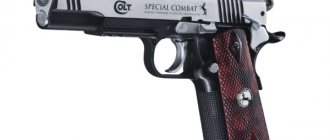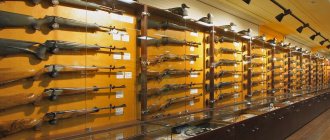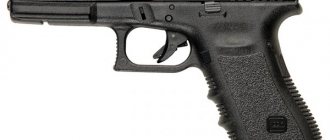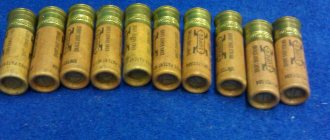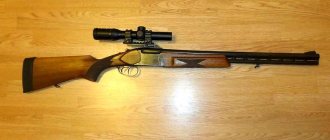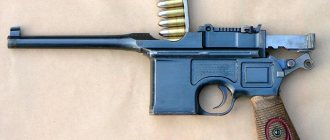Not to be confused with .38 ACP.
| .380 ACP | |||
| .380 ACP pistol cartridge from Sellier & Bellot. | |||
| Type | Gun | ||
| Place of origin | United States | ||
| Production history | |||
| Designer | John Browning | ||
| Manufacturer | Colt Manufacturing Company | ||
| Produced | 1908–present | ||
| Characteristics | |||
| Type of shell | Rimless, straight | ||
| Bullet diameter | 0.355 in (9.0 mm) | ||
| Neck diameter | 0.373 in (9.5 mm) | ||
| Base diameter | .374 inches (9.5 mm) | ||
| Rim diameter | .374 inches (9.5 mm) | ||
| Rim thickness | 0.045 in (1.1 mm) | ||
| Case length | 0.680 in (17.3 mm) | ||
| Full Length | 0.984 in (25.0 mm) | ||
| Maximum pressure | 21,500 psi Inch (148 MPa) | ||
| Ballistic characteristics | |||
| 210 ftlbf (280 J) | |||
| 95 g (6 g) Federal FMJ | 980 ft/s (300 m/s) | 203 ft⋅lbf (275 J) | |
| 100 gr (6 g) Buffalo HC-FN | 975 ft/s (297 m/s) | 211 ft⋅lbf (286 J) | |
| 95g (6g) Buffalo JHP+P | 1,125 ft/s (343 m/s) | 267 ft⋅lbf (362 J) | |
| 45 g (3 g) RBCD TFSP | 1,835 ft/s (559 m/s) | 337 ft⋅lbf (457 J) | |
0.380 ACP
(9×17mm) (Automatic Colt Pistol) is a Rimless, straight-wall pistol cartridge developed by firearms designer John Moses Browning.
Cartridge headspaces at the mouth of the case. [2] It was introduced in 1908 by Colt for use in its new pocket hammerless semi-automatic Colt Model 1908 and has since been a popular self-defense cartridge, widely used in numerous handguns (usually small guns). Other names for the .380 ACP include .380 Auto
,
9×17mm
,
9mm Browning
,
9mm Corto
,
9mm Kurz
,
9mm Short
and
9mm Browning Court
(this is the CIP designation). Not to be confused with .38 ACP.
Design[edit]
The .380 ACP cartridge was derived from Browning's earlier .38 ACP design, which was only slightly more powerful. The .380 ACP was designed to be rimless and have a free space on the case mouth instead of a rim for greater accuracy. These relatively low-powered designs were intended for blowback pistols, which lacked the barrel locking mechanism that is often required for any pistol firing a cartridge more powerful than the .380. Using the reverse inlet mode simplifies the design and reduces cost; a locking mechanism is not needed since the mass of the bolt and the force of the recoil spring are sufficient to absorb the recoil energy of the shot due to the bolt's relatively low thrust. The blowback mode also allows the barrel to be permanently locked to the frame, which improves accuracy, unlike a traditional short recoil pistol that requires a tilting barrel to unlock the slide and barrel assembly when riding a bicycle. The disadvantage of this system is that it requires a certain amount of bolt mass to counteract the recoil of the cartridge used. The higher the power of the cartridge, the heavier the bolt assembly must be for its inertia to safely absorb recoil, meaning that a typical blowback pistol of a given caliber will be heavier than an equivalent recoil-operated weapon. Blowback guns can be made in calibers larger than .380 ACP, but the required bolt weight and spring strength make this an unpopular option. Although the low power .380 ACP does not require a locking mechanism, there are a number of locked breech pistols chambered for the .380 ACP cartridge, such as the Remington Model 51, Kel-Tec P3AT, and Glock 42; all three are designed to be lighter than .380 ACP blowback weapons. There were also some relatively tiny (breech-operated) submachine guns, such as the Ingram MAC-11[3][4] and Czech vz. 83. [5]
Users[edit]
The .380 ACP has become very widespread in the years since its introduction (1908 USA, 1912 Europe). It was later adopted by the armies of at least five European countries as the standard pistol cartridge before World War II; Czechoslovakia (Vz.38), Hungary (FEMARU 37M) and Italy, all of which used domestic designs, as well as the Netherlands and Yugoslavia, both of which adopted the FN Model 1922. It was also widely used by Germany, which captured or purchased hundreds of thousands of pistols in this caliber during World War II. Popular German commercial models such as the Walther PPK were very popular among German officers. The Italian Army used the Beretta M1934, but the Italian Air Force and Navy stuck with the 7.65mm/.32 ACP when they adopted the Beretta M1935.
While the .380 ACP was considered a moderately powerful service pistol cartridge before World War II compared to the .32 ACP pistols it replaced, no country retained it as a military service cartridge for very long after the war ( when it was largely replaced by the more powerful 9×19mm Parabellum). It was widely used by police in Europe until at least the 1970s, when more powerful 9×19mm pistols began to replace it in that market as well. It finds some use as a backup weapon due to the generally small and easily concealable size of the weapons it is composed of (very few "mini pistols" are made in calibers larger than .380 ACP, and the few that are , are recent developments.) and are popular in the civilian market as a personal defense round. The .380 ACP cartridge is suitable for self-defense situations as the cartridge of choice for concealed carry pistols. This was the cartridge that was used in Defense Distributed's "Wiki Weapon" project to successfully 3D print firearms.
Review of the most popular pistols chambered for .380 (9mm) caliber in the USA
Is it acceptable to call the .380 cartridge an anachronism? Let us remember that this cartridge was developed by John Browning and has been in production since 1908, being a popular cartridge for self-defense weapons. Judging by the models of pistols chambered for the .380 cartridge offered on the US civilian arms market, we can say that it is too early to write off this cartridge.
So, sales of the Berreta Pico pistol chambered for the .380 caliber should soon begin.
And today we will briefly talk about the five most popular pistols that are offered on the American market chambered for the .380 caliber cartridge. Walther PPK
The Walther PPK is a great pistol. This is one of the pistols that has remained in production for a long time and is in steady demand. And, without a doubt, Walther PPK will be in production for a long time.
It should be noted that the Walther PPK is available in various calibers and, for example, in the version chambered for the .22 caliber cartridge, the Walther PPK has a frame made of alloy, and in versions for other calibers the pistol frame is made of steel.
The use of steel and alloys makes Walther PPK more expensive compared to its polymer competitors, and the high cost is perhaps the only drawback of PPK.
Colt Mustang
Next on our list of polymer madness fighters is the Colt Mustang, a scaled-down model of the legendary Colt M1911. This is his younger brother, so to speak. The Colt Mustang recently received a mild facelift and remains in strong demand.
One of the features of the Colt Mustang that makes it attractive in the market is the stamped frame. Another advantage is that for users of the full-size Colt M1911, the transition to the Colt Mustang will be completely invisible. The reason is that the ergonomics of these pistols are almost the same.
It is also worth noting that, following modern trends, the manufacturer still produces the Colt Mustang with a polymer frame.
SIG P238
Despite the fact that the Sig company keeps up with the times and produces small arms using polymers with all its might, the Sig P238 pistol chambered for the .380 cartridge Sig released with a metal frame.
The Sig company has a global reputation for producing reliable and high-quality small arms, so the Sig P238 pistol was no exception. This pistol is a great addition as a utility weapon or home defense pistol.
Bersa Thunder
The Bersa Thunder pistol, similar to the Walther PPK, however, is a completely different pistol and one of its main advantages is its lower price compared to the Walther PPK. But it's not just the price that makes it popular. Reliability is what attracts new fans to him and does not turn away old ones. It just so happens that weapons that work reliably have a habit of being popular.
Select models of this pistol cost less than $300, so a Bersa Thunder owner won't have to worry too much if the pistol gets a scratch or dent.
Beretta Cheetah
Compared to its competitors, the Beretta Cheetah pistol feels heavy, large, and somewhat dated. But the Beretta Cheetah easily finds fans among those for whom size matters and who care about the impression the gun makes on a lawbreaker. As the hero of one action movie said, “The gun must be heavy... so that you can hit” (this is a joke - do not use a pistol for hitting).
The large size of the Beretta Cheetah relative to its .380-cartridge counterparts also makes them more comfortable to operate, as it is more grippy and fits snugly in the hand. In the end, the Beretta Cheetah is very similar to the legendary Beretta M9 pistol, which is not the least important for those who want to purchase it. Plus, the Beretta Cheetah is cheaper.
Conclusion
After throwing around the cards, I still haven’t come to any clear understanding of what the future holds for pistols chambered for the .380 caliber. There is still a huge market in which all of the above pistols are in demand and I believe they will be in demand for a long time. The reasons for this, in my opinion, are that pistols chambered for the .380 cartridge are very convenient, cheap, aesthetically beautiful and stylish. Well, besides, not having the power of a 9x19mm cartridge, a .380 caliber cartridge allows this weapon to be a completely adequate small arms for protecting yourself, your loved ones and your home from uninvited guests.
Performance[edit]
.380 ACP compared to the 9mm Luger cartridge.
The .380 ACP is compact and lightweight, but has a relatively short range and less stopping power than other modern handgun cartridges. [6] According to weapons author Masad Ayoub, "Some experts will say it is not enough, and others will say it is completely inadequate." [7] However, it remains a popular self-defense cartridge among shooters who want a lightweight and/or smaller pistol with manageable recoil. It is slightly less powerful than the standard pressure .38 Special and uses 9 mm (0.354 in) diameter bullets. Standard bullet weights are usually 85, 90, 95, 100, 115 and 120 grains. [8] [9]
The killing potential of bullets is often characterized by the bullet's expanded diameter, penetration depth, and energy. Bullet energy for .380 ACP loads ranges from approximately 190 to 294 ft-lbf (258 to 399 J). [10] The table below shows general performance parameters for several .380 ACP loads. Bullets weighing between 85 and 95 g (5.5 and 6.2 g) are common. Penetration depths from 6.5 to 17 inches (16.5 to 43.2 cm) are available for a variety of applications and risk assessments.
| Manufacturer | Load | Weight | Speed | Energy | Extension (inches) [11] | Penetration [11] | PC [11] | TSC [11] |
| ATOMIC Ammunition | Bond JHP | 90 gr (5.8 g) | 1,100 ft/s (340 m/s) | 241 ft⋅lbf (327 J) | 0.64 inches (16.3 mm) | 12.0 in (304.8 mm) | N.A. | N.A. |
| Cor Bon | JHP | 90 gr (5.8 g) | 1,050 ft/s (320 m/s) | 220 ft⋅lbf (300 J) | 0.58 in (14.7 mm) | 9.0 in (228.6 mm) | 2.38 USD inches (39.0 cm 3 ) | 15.7 USD inches (257.3 cm 3 ) |
| Federal | HydraShok JHP | 90 gr (5.8 g) | 1000 ft/s (300 m/s) | 200 ft⋅lbf (270 J) | 0.58 in (14.7 mm) | 10.5 inches (266.7 mm) | 2.77 USD inches (45.4 cm 3 ) | 21.0 USD inches (344.1 cm 3 ) |
| Winchester | Silvertip JHP | 85 g (5.5 g) | 1000 ft/s (300 m/s) | 189 ft⋅lbf (256 J) | 0.63 in (16.0 mm) | 6.5 inches (165.1 mm) | 2.03 USD inches (33.3 cm 3 ) | 10.6 USD inches (173.7 cm 3 ) |
| Speer | JHP | 88 g (5.7 g) | 1000 ft/s (300 m/s) | 196 ft⋅lbf (266 J) | 0.36 in (9.1 mm) | 17.0 in (431.8 mm) | 1.73 USD inches (28.3 cm 3 ) | 9.1 cu. Inches (149.1 cm 3 ) |
| Hornady | XTP | 90 gr (5.8 g) | 1000 ft/s (300 m/s) | 200 ft⋅lbf (270 J) | 0.44 inches (11.2 mm) | 11.8 inches (299.7 mm) | 1.73 USD inches (28.3 cm 3 ) | 9.1 cu. Inches (149.1 cm 3 ) |
| Federal | FMJ | 95 g (6.2 g) | 955 ft/s (291 m/s) | 193 ft⋅lbf (262 J) | 0.36 in (9.1 mm) | 17 inches (431.8 mm) | 1.73 USD inches (28.3 cm 3 ) | 8.7 USD in (142.6 cm 3) |
Key:
- Expansion
- increased bullet diameter (ballistic gelatin). - Penetration
- penetration depth (ballistic gelatin). - PC
—volume of the permanent cavity (ballistic gelatin, FBI method). - TSC
is the volume of temporary cavity distension (ballistic gelatin).
Encyclopedia of weapons
Cartridge 9x17 mm Browning (.380 ACP), 1910, Belgium
Performance characteristics of 9x17 mm Browning (Kurz)
Caliber, mm — 9x17 mm Browning Cartridge length, mm — 25 Case length, mm — 17.3 Bullet lead diameter, mm — 9.02 Case shoulder diameter, mm — 9.53 Case base diameter, mm — 9.50 Diameter case flange, mm - 9.50 Case flange thickness, mm - 1.25 Cartridge weight, g - 9.6 Bullet weight, g - 5.9-6.2 Gunpowder weight, g - 0.25 Muzzle velocity, m /s - 270-308 Muzzle energy, J - 224-280
The world-famous gunsmith John Moses Browning created a 9x17 mm caliber cartridge. for the American company Colt in 1908. The 9×17 cartridge itself is developed on the basis of the 9 mm Browning Long cartridge, created for the Belgian company FN in 1903.
The 9×17 cartridge case is cylindrical in shape, made of steel clad with copper or brass (can be knurled). Jacketed bullet with a lead core. The shell is usually tombak with a thickened front part to increase penetration ability.
For the 9x17 mm cartridge, the following characteristics are typical: cartridge weight - 96 grams, bullet weight - from 5.9 to 6.2 grams, muzzle velocity - from 270 to 308 m/s, muzzle energy of the bullet - 224-280 J.
In 1910, the Belgian company FN (Fabrique Nationale) also began producing weapons of the Browning design chambered for this cartridge, designating it 9 mm Browning Short. In the USA, this cartridge appeared under the designation .380 ACP.
Between World Wars I and World War II, the 9x17 cartridge gained popularity on both continents as police and civilian ammunition in examples such as the FN-Browning model 1910 and 1922 pistols, and the Colt "pocket model". Later, such pistols as Walter PP, Mauser HSC (HSc), Colt “Mustang” and “Officer Model”, FN Model 140 and many others were produced for this ammunition.
Based on the 9x17 cartridge, the Soviet 9x18 PM cartridge was also developed. In Russia, the 9x17 cartridge has been produced since 1996 by the Tula Cartridge Plant and is known as 9x17 mm K.
After certification of the 9×17 cartridge in Russia, it was accepted as service ammunition, and a modification of the PM pistol under the designation IZH-71 and a number of pistols and revolvers are produced for it.
Russian-made cartridges are weaker than 9x18 PM cartridges due to the lower initial velocity of the bullet, which instead of a steel core has a soft lead center and a soft shell clad with tombak (a soft alloy consisting of 90% copper and 10% zinc).
If we compare the 9x17 cartridge with the .45 ACP (11.43x23 mm) and 9x19 Parabellum cartridges, then this ammunition is almost a child’s toy. It is not random shooting in his direction that can definitely hit or incapacitate a person from such a weapon, but only accurate shooting to kill, so that not one, but several bullets hit some unprotected place (i.e. a place not protected by body armor) . Only in this case does it become possible to seriously hit the enemy.
However, despite the insufficient destructive power of the bullet and other above-mentioned disadvantages, this cartridge is one of the most successful pistol cartridges, because the low initial velocity of the bullet, combined with low recoil force, has a positive effect on the constancy of the fight and shooting accuracy, and, among other things, reduces the likelihood of ricochet.
In addition, the qualities of the cartridge make it possible to design light and compact weapons for it, and the subsonic speed of the bullet allows the use of simple silencers.
The 9×17 cartridge has the following designations: 9 mm Browning Court / 9 mm Browning Short / 9 mm Browning Kurz / 9 mm Browning Corto / 9 mm Short / 9mm Kratak / 9 mm k / 9mm Scurt / 9 mm m.34 / 9 mm Beretta m.1934 / 9 mm Selbstladepistole (.380) / .380 ACP / .380 Auto / .380 Auto Pistol / .380 CAPH / .380 Colt Auto Pistol Hammerless / DWM 540.
‹ Cartridge 8×9 R Up Cartridge 9×18 Ultra ›
Synonyms [edit]
- 9 × 17 mm
- USA - .380 Auto, .380 ACP.
- EU Spanish and Italian - 9mm Corto / 9mm Short
- French - 9 mm court / 9 mm short
- Portuguese – 9mm Curto / 9mm Short
- Dutch - 9mm Kort / 9mm Short
- Bosnian – 9 mm Kratak / 9 mm Short
- Western South Slavic (Serbo-Croatian, Slovenian) - 9 mm Kratak / 9 mm short, Kratka 9 (Kratka Devetka) / Short 9 (Short Nine)
- Eastern South Slavic (Bulgarian, Macedonian) - 9 mm Kas / 9 mm Short
- German – 9mm Kurz / 9mm Short
- Romanian - 9 mm Scurt / 9 mm Short
- UK - 9 mm Browning, 9 mm Browning Short, 9 mm Short.
Cartridge 9×17/.380 ACP
The 9×17 cartridge has the following designations: 9 mm Browning Court / 9 mm Browning Short / 9 mm Browning Kurz / 9 mm Browning Corto / 9 mm Short / 9mm Kratak / 9 mm k / 9mm Scurt / 9 mm m.34 / 9 mm Beretta m.1934 / 9 mm Selbstladepistole (.380) / .380 ACP / .380 Auto / .380 Auto Pistol / .380 CAPH / .380 Colt Auto Pistol Hammerless / DWM 540.
9×17
World famous gunsmith John Moses Browning created cartridge caliber 9x17 mm. for the American company Colt in 1908.
The 9×17 cartridge itself is developed on the basis of the 9 mm Browning Long cartridge, created for the Belgian company FN in 1903.
The 9×17 cartridge case is cylindrical in shape, made of steel clad with copper or brass (can be knurled). Jacketed bullet with a lead core. The shell is usually tombak with a thickened front part to increase penetration ability.
For the 9x17 mm cartridge, the following characteristics are typical: cartridge weight - 96 grams, bullet weight - from 5.9 to 6.2 grams, muzzle velocity - from 270 to 308 m/s, muzzle energy of the bullet - 224-280 J.
In 1910, the Belgian company FN (Fabrique Nationale) also began producing weapons of the Browning design chambered for this cartridge, designating it 9 mm Browning Short.
In the USA, this cartridge appeared under the designation .380 ACP.
9×17
Between World War I and World War II, the 9×17 cartridge gained popularity on both continents as police and civilian ammunition in examples such as the FN-Browning model 1910 and 1922 pistols, and the Colt "pocket model". Later, such pistols as Walter PP, Mauser HSC (HSc), Colt “Mustang” and “Officer Model”, FN Model 140 and many others were produced for this ammunition.
Based on the 9x17 cartridge, the Soviet 9x18 PM cartridge was also developed.
In Russia, the 9x17 cartridge has been produced since 1996 by the Tula Cartridge Plant and is known as 9x17 mm K.
After certification of the 9×17 cartridge in Russia, it was accepted as service ammunition, and a modification of the PM pistol under the designation IZH-71 and a number of pistols and revolvers are produced for it.
9×17
Russian-made cartridges are weaker than 9x18 PM cartridges due to the lower initial velocity of the bullet, which instead of a steel core has a soft lead center and a soft shell clad with tombak (a soft alloy consisting of 90% copper and 10% zinc).
If we compare the 9x17 cartridge with the .45 ACP (11.43x23 mm) and 9x19 Parabellum cartridges, then this ammunition is almost a child’s toy. It is not random shooting in his direction that can definitely hit or incapacitate a person from such a weapon, but only accurate shooting to kill, so that not one, but several bullets hit some unprotected place (i.e. a place not protected by body armor) . Only in this case does it become possible to seriously hit the enemy.
However, despite the insufficient destructive power of the bullet and other above-mentioned disadvantages, this cartridge is one of the most successful pistol cartridges, because the low initial velocity of the bullet, combined with low recoil force, has a positive effect on the constancy of the fight and shooting accuracy, and, among other things, reduces the likelihood of ricochet. In addition, the qualities of the cartridge make it possible to design light and compact weapons for it, and the subsonic speed of the bullet allows the use of simple silencers.
| 9×17 |
Links[edit]
- "Federal Cartridge Ballistics". Patron Federal. Archived from the original on September 27, 2007. Retrieved September 25, 2007.
- Wilson, R. K. Textbook of Automatic Pistols
, page 241. Plantersville, SC: Small Arms Technical Publishing Company, 1943. - "Ingram MAC Model 10/M10 and Model 11/M11 Submachine Guns (USA)". Archived from the original on September 29, 2007. Retrieved September 25, 2007.
- Iannamico, Ian. "History of the Ingram-MAC Type Firearms Manufacturing." Small Arms Review
.
Chipotle Publishing, LLC. 20
(1): 102. - Jones, Richard (2009). Jane's Infantry Weapons 2009-2010
. Jane Information Group. paragraph 107. ISBN 978-0-7106-2869-5. - ".380ACP Terminal Ballistics". Archived from the original on October 16, 2007. Retrieved September 25, 2007.
- Ayoub, Massad. (2007) Pistol Digest of Combat Small Arms. Krause Publications. Page 97. ISBN 0-89689-525-4.
- Thomas J. Griffin, ed. (2002). Lyman 48th Edition Reloading Guide
. paragraph 321. - ↑
Richard Mann (10 April 2012). ".380 ACP DRT 85-grain". Retrieved October 28, 2022. - ↑
"380 Auto + Pistol & Handgun Ammunition".
www.buffalobore.com
. Archived from the original on 2019-01-02. Retrieved January 2, 2019. - ^ abcd Marshall, Evan P.; Sanow, Edwin J. (1996), "Appendix A", Street Stoppers
, Paladin Press, ISBN 978-0-87364-872-1
